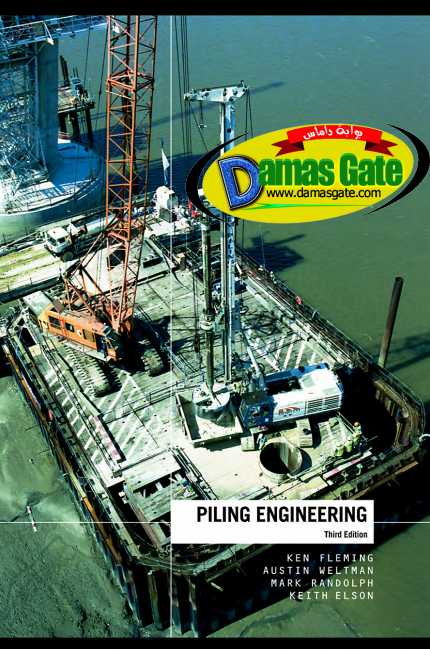Piling Engineering - 3rd Edition

Introduction
Since man first sought to establish secure dwellings and to cross streams and rivers
where fluctuating water levels gave an element of uncertainty to travel arrangements,
the driving of robust stakes or piles in the ground has provided a means whereby the
hazards of living could be reduced.
Various peoples in different parts of the world found it convenient to dwell by lake
shores where food, water and easy transport were readily to hand and where water
levels remained reasonably constant. Evidence of piled settlements has been found on
the borders of lakes in, for example, Switzerland, Italy, Scotland and Ireland.
It is believed that some of these settlements were in use about 4000 years ago and
they were sometimes of considerable size, as on the shores of Lake Geneva opposite
Morges. In another settlement at Robenhausen, it has been estimated that over 100 000
piles had been used. In this case the piles were beneath a covering of peat moss which
it is reckoned would have taken at least 2000 years to form. Recent archaeological
excavations elsewhere in Switzerland and in France have confirmed that piles were
used widely for housing along marshy lake shores.
At Lough Drumkeery in Co. Cavan, Ireland, about 30 000 ancient piles including
primitive sheet piles were found in l863. These consisted of birch and oak, and the
oak piles had been carefully pointed and driven to a depth of about 3 m.
The first historical reference to piling appears to be by Herodotus, the Greek writer
and traveller who is sometimes referred to as the ‘father of history’ and who lived in the
fourth century b.c. He records how a Thracian tribe, the Paeonions, lived in dwellings
erected on lofty piles driven into a lake bed. The piles were driven under some kind
of communal arrangement but after a time a law had been made that when a man
wished to marry, he had first to drive three piles. Since the tribe was polygamous,
the number of piles installed was considerable. This system provided a unique and
practical method of founding an expanding settlement.
Download
http://s18.alxa.net/s18/srvs2/02/001...rd.Edition.rar

Introduction
Since man first sought to establish secure dwellings and to cross streams and rivers
where fluctuating water levels gave an element of uncertainty to travel arrangements,
the driving of robust stakes or piles in the ground has provided a means whereby the
hazards of living could be reduced.
Various peoples in different parts of the world found it convenient to dwell by lake
shores where food, water and easy transport were readily to hand and where water
levels remained reasonably constant. Evidence of piled settlements has been found on
the borders of lakes in, for example, Switzerland, Italy, Scotland and Ireland.
It is believed that some of these settlements were in use about 4000 years ago and
they were sometimes of considerable size, as on the shores of Lake Geneva opposite
Morges. In another settlement at Robenhausen, it has been estimated that over 100 000
piles had been used. In this case the piles were beneath a covering of peat moss which
it is reckoned would have taken at least 2000 years to form. Recent archaeological
excavations elsewhere in Switzerland and in France have confirmed that piles were
used widely for housing along marshy lake shores.
At Lough Drumkeery in Co. Cavan, Ireland, about 30 000 ancient piles including
primitive sheet piles were found in l863. These consisted of birch and oak, and the
oak piles had been carefully pointed and driven to a depth of about 3 m.
The first historical reference to piling appears to be by Herodotus, the Greek writer
and traveller who is sometimes referred to as the ‘father of history’ and who lived in the
fourth century b.c. He records how a Thracian tribe, the Paeonions, lived in dwellings
erected on lofty piles driven into a lake bed. The piles were driven under some kind
of communal arrangement but after a time a law had been made that when a man
wished to marry, he had first to drive three piles. Since the tribe was polygamous,
the number of piles installed was considerable. This system provided a unique and
practical method of founding an expanding settlement.
Download
http://s18.alxa.net/s18/srvs2/02/001...rd.Edition.rar